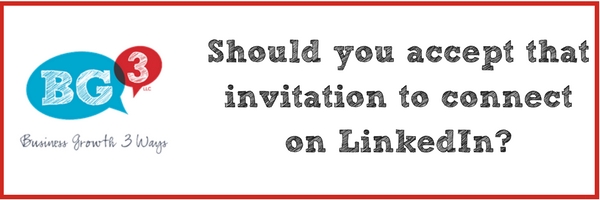
This question is asked a lot with regard to LinkedIn: Should I accept that invitation to connect?
It’s a valid question. You don’t know the person who sent the invitation, and you’re not sure what they need, so you’re a little hesitant to accept.
LinkedIn says you should not accept invitations from people that you don’t know, and more importantly, you shouldn’t send invitations to connect with people you don’t know. But honestly, it seems against the whole point of networking in the first place. LinkedIn is a networking site and we want to expand our circle of contacts and be introduced to new people and learn from them.
So, what does that mean for you? Well, you shouldn’t necessarily accept every single invitation you receive, but you also shouldn’t reject every single invitation you receive.
Here are 3 things to consider before you hit the accept or ignore button:
1. Take a look at the message itself
- Sometimes on the mobile app, or even on the new desktop version, you don’t always see the full message from the invitation that was sent. Make sure to click through and read the whole message.
- See if they took the time to personalize the message or if it was just the default LinkedIn message. The default message tends to indicate that they may not have the time to really connect and answer questions or share quality content down the road.
- Does the invitation give any indication of what they want? Simply saying that they want to connect with you is great, but why do they want to connect? Was it something they read on my profile, or maybe something I posted recently, or someone that we know in common? Having that context will help you decide if you should accept the invitation and potentially meet with the person.
- Look for typos or poor grammar in the invitation. Things like that are often a sign that the message is spam.
2. Take a look at the LinkedIn profile of the sender
- Do they have a professional image? If they aren’t willing to share who they are, it raises a red flag.
- Is their profile filled out completely? Can you get a sense of who they are?
- Where are they from? Do they do business in an area or a country that you don’t do business in? That would likely influence your decision to connect.
- Do they have any endorsements or recommendations? It takes time to build connections and get those endorsements. If they do, that will help to alleviate any concerns about them having a spam/fake account.
- Are they active on LinkedIn? Are they simply adding everyone in an effort to grow their network, or are they actually taking the time to post and engage on LinkedIn? Are they posting, liking, and/or commenting pretty regularly?
3. Do you have mutual connections?
- Who do you have in common? What do you think of or know about the mutual connections you have? You can always ask your mutual connection what they know about the sender and gain a little of information that way.
- How many connections do they have? Do they have many, or are they just starting out? For those just starting a new profile, they’ll likely reach out to connect with people that they know first, before expanding their circle. If they have less than 100 connections and you don’t know them, that could potentially raise another red flag.
Finally, after you’ve considered all 3 of the areas mentioned above, there’s one final litmus test: Would you be willing to spend 15 minutes on the phone or meet up for coffee with this person to have a conversation? If not, there’s no point in having them in your network.
As always, here is a handy guide for you to reference if this situation happens to you. http://bg3llc.com/wp-content/uploads/Should-you-connect-on-LinkedIn.pdf






